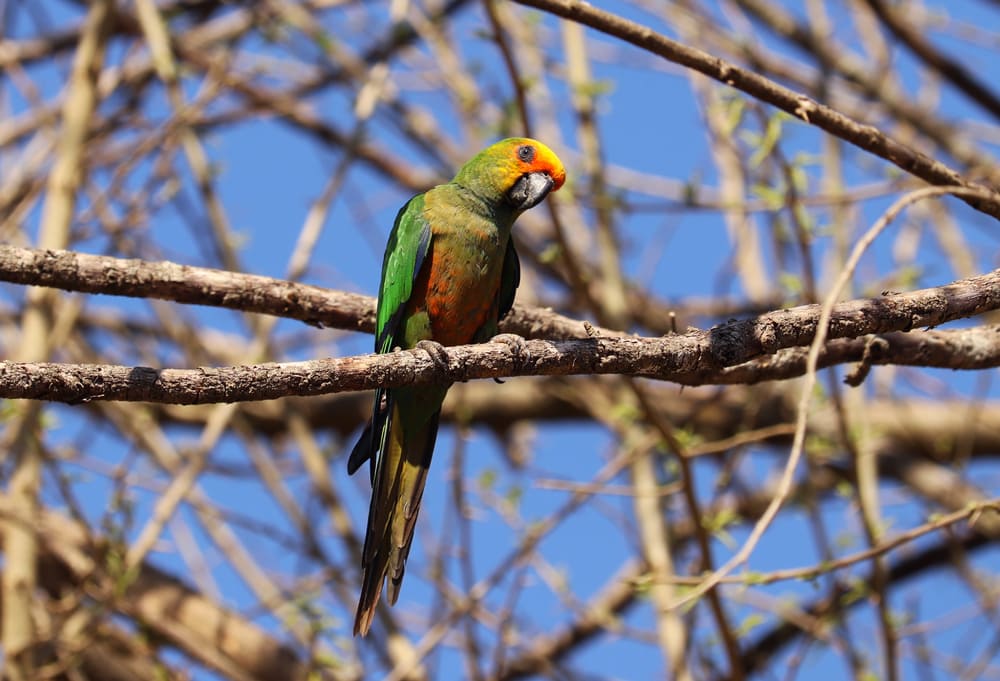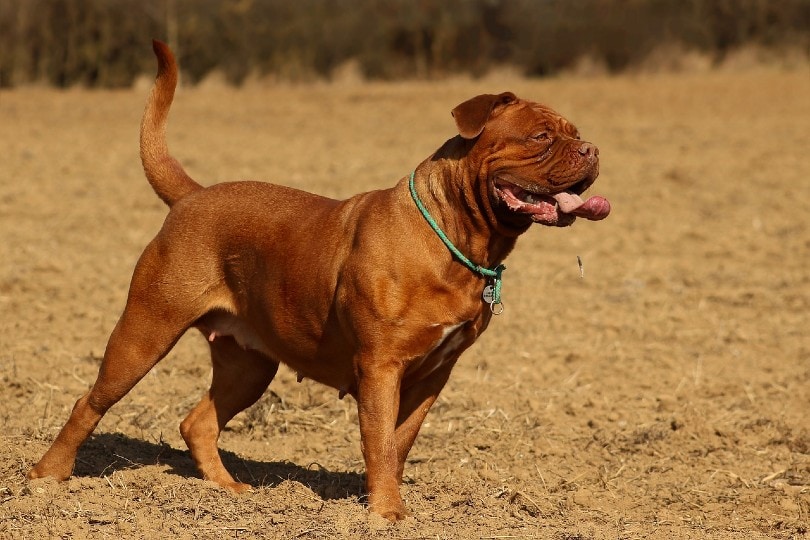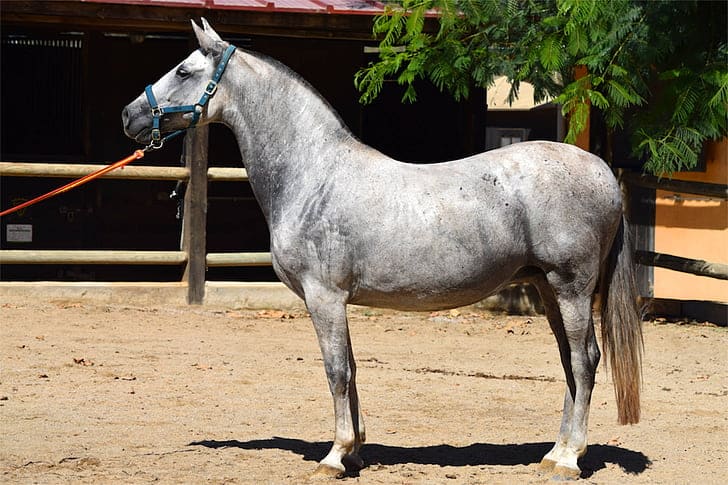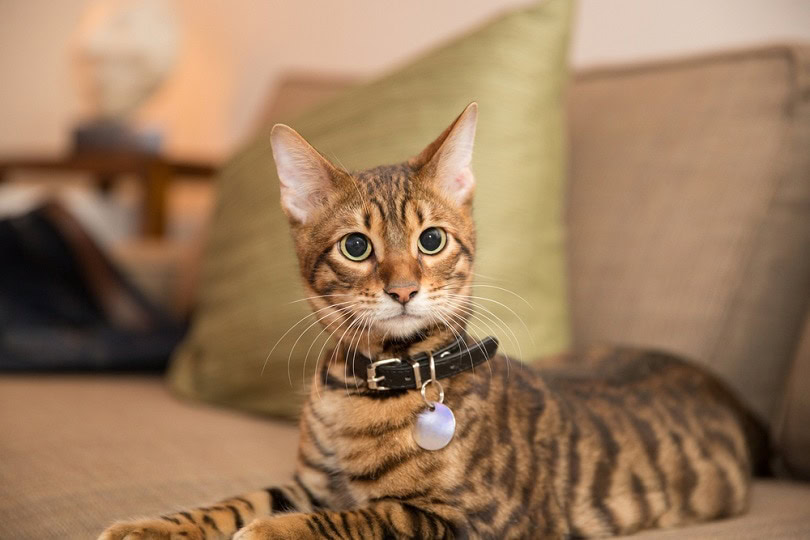Click to Skip Ahead
The Golden-capped conure is a vibrant, lively parrot species that hails from Brazil and Paraguay’s subtropical forests. In the wild, they can be found in flocks of 30 or more birds. Having reached Near-Threatened status, their wild numbers have been dwindling due to habitat loss as a result of deforestation.1
The Golden-capped conure is easily bred in captivity and is commonplace in the pet trade. These birds range from 11 to 14 inches in length and weigh between 4.5 and 5.5 ounces. They are colorful, loveable, and full of personality, and they can make wonderful long-term companions.

Species Overview
| Common Names: | Golden-capped Conure, Golden-capped Parakeet, Flame-capped Parakeet, Golden-headed Conure |
| Scientific Name: | Aratinga auricapillus |
| Adult Size: | 11–14 inches, 4.5–5.5 ounces |
| Life Expectancy: | 20–30 years |

Origin and History
The Golden-capped conure belongs to the Arantinga genus of South American conures that look alike and have similar physical characteristics. Other members in this genus include the Sun conure, Jenday conure, and the Golden-fronted conure.
Native to Brazil and Paraguay, the Golden-capped conure resides in the subtropical and tropical dry forests, moist lowland forests, dry savanna, and plantations of their homeland.
They live in flocks of 30 or more and spend their time foraging for food and nesting high in the treetops. Once abundant in their native lands, the wild population is quickly vanishing due to deforestation.
Golden-capped conures are fairly easy to breed in captivity, where their numbers are vast.
Temperament
Golden-capped conures are very outgoing, social birds who enjoy being near their human companions as much as possible. They are very intelligent and respond well to training with positive reinforcement. If trained properly and exposed to consistent communication, they can learn to repeat words and perform tricks.
Conures are known for being active and playful. Chewing, climbing, dancing, and swinging are popular activities among these birds. They need a spacious and enriching environment full of toys and various forms of entertainment. They can get destructive if left unsupervised around household items.
You can expect your Golden-capped conure to demand your time and affection. They love to cuddle and will happily crawl on your shoulder and go along for the ride. Quality time with their human companions is essential for their mental health. They make for a pretty comical household pet.
The Golden-capped conure is not a quiet bird. You will undoubtedly be greeted very enthusiastically when you arrive home. They have loud, shrill screams and can be incredibly vocal at dawn and dusk. Conures are notoriously nippy. You must implement proper training to ensure you have a well-mannered bird.
- Friendly and playful
- Cuddly
- Entertaining and comical
- Biting tendencies
- Loud and shrill
- Destructive
Speech & Vocalizations
Golden-capped conures have a signature high-pitched, shrill screech. They vocalize the most when they are excited, longing for attention, or startled.
They can learn to speak a few words and phrases but don’t have a vast vocabulary. You can expect them to learn and say 20 or more words regularly, though the Golden-capped conure does not speak as clearly as other parrots.

Golden-Capped Conure Colors and Markings
The Golden-capped conure has a slightly larger, more blocky body than the Sun and Jenday conures. They do not reach full coloration until approximately 1 year of age.
They have green bodies that can take on a more aqua hue in sunlight. The eyes are surrounded by a white ring, and a red band surrounds the white area. The tail has varying hues of yellow, green, and blue, and the signature golden crown is at the top of the head.
Caring for the Golden-Capped Conure
You’ll want a spacious cage for the Golden-capped conure. They need to move around and exercise in their enclosure. Perches, swings, ladders, bells, and bird-safe chewable toys are essential cage accessories.
Golden-capped conures can get along well with other conures and, in some cases, other birds that are the same size or smaller. It is hard to determine whether an individual bird will be compatible with another. Golden-capped conures can thrive as a single bird as long as they get a minimum of 2 hours of human interaction daily and are not left alone any longer than 6 to 8 hours.
The Golden-capped conure’s diet includes pellets, commercial birdseed, fruits, vegetables, and occasional treats.
The cage should be checked daily for debris that is accessible to your bird. To prevent any health issues, you will need to wipe down the cage, bowls, toys, and perches daily. The cage lining will need to be changed at least every other day. The entire cage should be cleaned thoroughly at least once every month with mild dishwashing liquid and water.
Your bird will need to bathe two to three times weekly. You can provide a bowl of lukewarm water or gently mist your bird with warm water from a clean spray bottle.
You must consult an avian veterinarian for your Golden-capped conure’s care. Your bird will require routine health exams, and you will need your veterinarian on standby for any unexpected health issues.
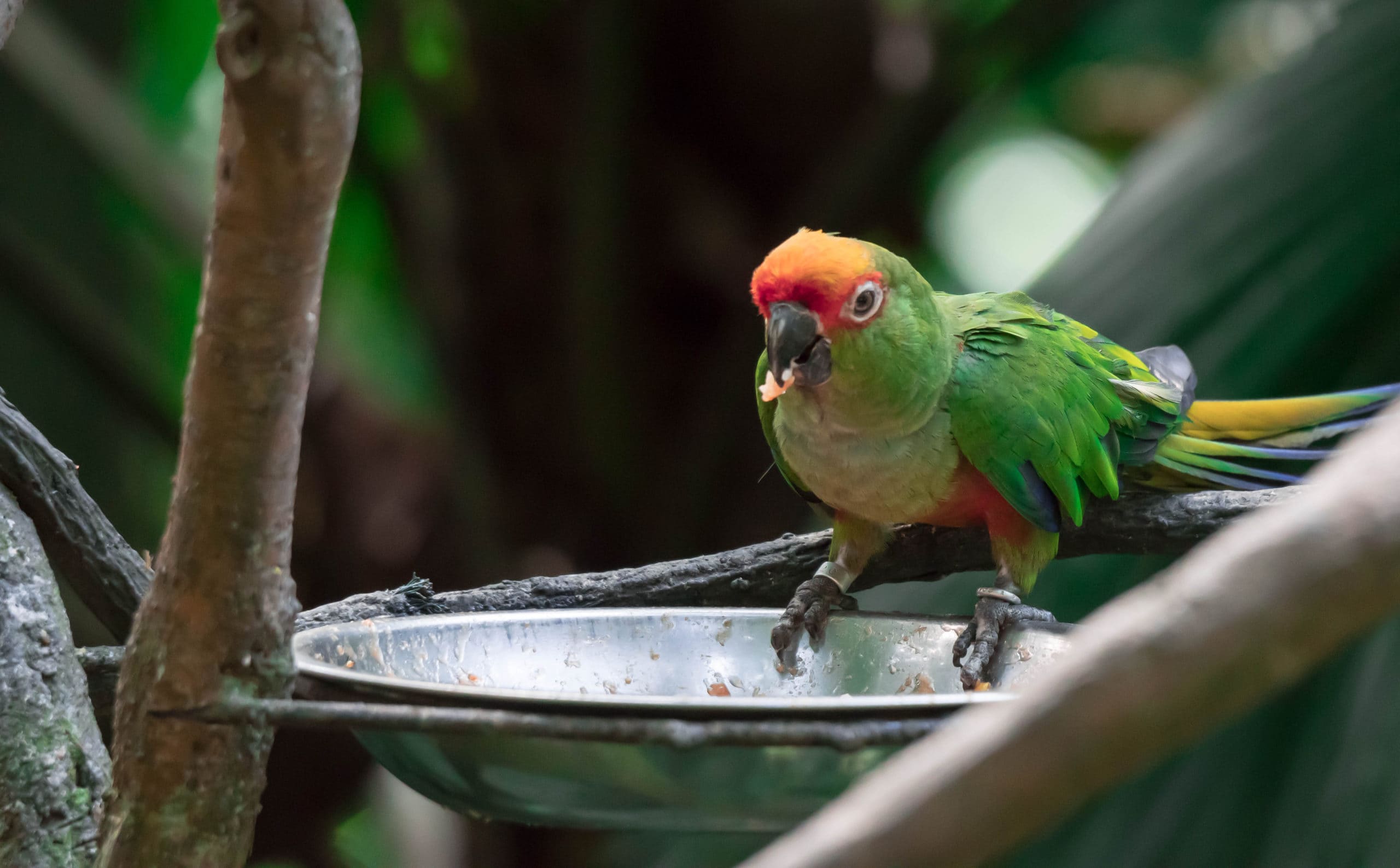
Common Health Problems
It is essential to be aware of the common health issues that affect the Golden-capped conure. Regular health examinations by an avian veterinarian are needed for your bird’s health and well-being.
Diet and Nutrition
Conures are vulnerable to obesity and nutritional deficiencies if their dietary needs are not met. A varied and well-balanced diet must be maintained at all times. You can discuss these dietary needs with your avian veterinarian to ensure you are feeding the most high-quality, healthy diet.
It is recommended that conures be fed a mixture of pellets and seeds as part of their base diet. They also require a variety of fresh fruits and vegetables for optimal nutrition. Below is a list of some acceptable fruits, vegetables, and greens that can be included in their diet:
- Mango
- Papaya
- Apples
- Grapes
- Cherries
- Oranges
- Pears
- Nectarines
- Apricots
- Asparagus
- Coconut
- Cucumber
- Melons
- Peppers
- Bananas
- Cooked Beans
- Pineapple
- Dandelion Leaves
- Kale
- Potatoes
- Berries
- Spinach
- Squash
- Cabbage
Exercise
Like most captive birds, Golden-capped conures require a lot of exercise and socialization. You need a spacious cage to house them and plenty of toys and perches to enrich their environment. These small parrots have abundant energy and must spend time outside their cage for optimal mental and physical stimulation.
Toys, ropes, ladders, and perches will encourage movement and activity. Golden-capped Conures like to be interactive with their surroundings. You will need to commit your own time to your bird’s daily exercise needs and supervise any time spent out of the cage. You can also keep them active by teaching them tricks.

Where to Adopt or Buy a Golden-Capped Conure
The Golden-capped conure is a very popular pet. They generally range in price from $250 to $600. There are many reputable breeders of Golden-capped Conures in the United States. Considering their popularity, they can also be found in pet stores nationwide.
Many pet birds are abandoned for various reasons. Thankfully, there are rescue groups in place for these kinds of situations. If you want to adopt a rescued Golden-capped conure, you can research the local bird rescues to find the perfect bird for you and your family.


Conclusion
The Golden-capped conure can make an excellent pet for the right person. They are common parrots that can be purchased at a reasonable price. Conures have charming personalities and are very affectionate with their humans.
They require physical activity, mental stimulation, and socialization. Owning a Golden-capped conure is a lengthy commitment, and you will want to ensure you can provide the care, time, and attention it takes for your bird to thrive in your home.
Next on your reading list:
Featured Image Credit: Floratta, Shutterstock
